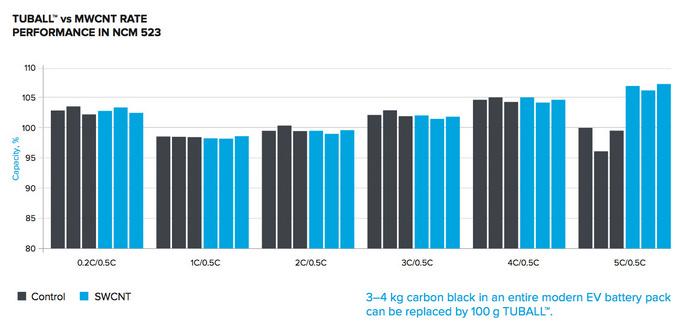To enable EV transportation, as announced by the majority of automakers, the energy density of Li-ion batteries needs to be significantly improved. LIB manufacturers from all over the world have a shared goal of reaching an energy density of 300 Wh/kg by 2020. The solution arises from advanced nanotechnology: TUBALL graphene nanotubes able to improve LIB performance, finally meeting strict EV requirements. This breakthrough technology will be presented at booth #1602 at the Battery Show in Novi, Michigan.
Among advanced anode materials for Li-ion batteries, silicon–carbon (Si/C) anodes demonstrate great potential due to their high capacity. However, there are still some serious obstacles for industrial use of Si/C anodes in LIB, one of which is poor cycle life. Graphene nanotubes – ultra-thin single-layer rolled sheets of graphene – could be the answer. Recently, OCSiAl, the world’s largest manufacturer of graphene nanotubes, has developed the first ready-to-use nanotube-based solution that efficiently solves this problem with Si/C anodes, enabling the use of high-energy Si/С anodes with good cycle-life in electric vehicles.
The ultra-fine and stable TUBALL graphene nanotubes in TUBALL BATT H2O fully covers and electrically connects Si/C anode particles during the charge-discharge process of LIBs, even during the harshest cycling conditions required by electric vehicles manufacturers. The nanotubes dispersion in water means you can simply mix it in with the Si/Gr anodes during the slurry manufacturing stage. Laboratory tests show that Si/C anode with TUBALL BATT H enable batteries to sustain 1,000 cycles and still retain 80% capacity.

TUBALL nanotubes offer the required conductivity, adhesion, safety, rate and cycle performance in cathodes starting from 0.06% loading, which is “best-in-class.” For reference, standard loading for conventional additives, such as MWCNTs or carbon black, is often 10–50 times higher. A result of such a low loading level of TUBALL allows maximizing the cathodes’ energy density by using a higher amount of active material: up to 99% in modern high-energy NCM and other cathode materials.

Visit OCSiAl at booth #1602 during the North American Battery Show on September 11–13 to gain more insights on how to penetrate the EV battery market using graphene nanotubes.
